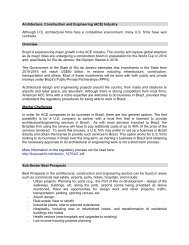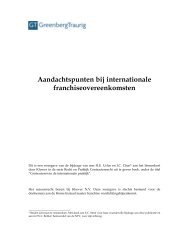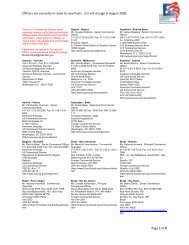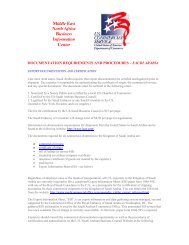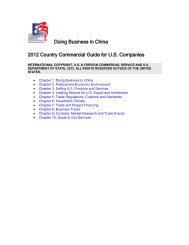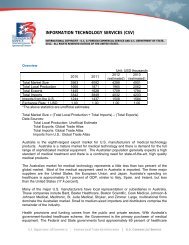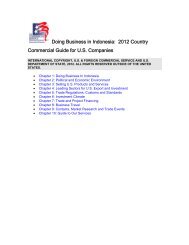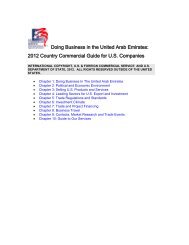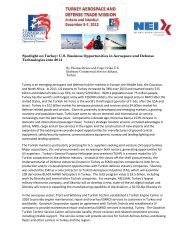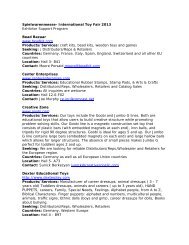2011 Bahrain Country Commercial Guide - US - Export.gov
2011 Bahrain Country Commercial Guide - US - Export.gov
2011 Bahrain Country Commercial Guide - US - Export.gov
Create successful ePaper yourself
Turn your PDF publications into a flip-book with our unique Google optimized e-Paper software.
Return to table of contents<br />
Chapter 5: Trade Regulations, Customs and Standards<br />
Import Tariffs<br />
Trade Barriers<br />
Import Requirements and Documentation<br />
U.S. <strong>Export</strong> Controls<br />
Temporary Entry<br />
Labeling and Marking Requirements<br />
Prohibited and Restricted Imports<br />
Customs Regulations and Contact Information<br />
Standards<br />
Trade Agreements<br />
Web Resources<br />
Import Tariffs Return to top<br />
With the entry into force of the U.S.-<strong>Bahrain</strong> Free Trade Agreement in August 2006,<br />
bilateral trade in industrial and consumer products, with the exception of a few<br />
agricultural items, is now duty free. <strong>Bahrain</strong> will phase out tariffs on the remaining<br />
handful of agricultural product lines by 2015. Textiles and garments are duty exempt,<br />
providing new opportunities for U.S. and <strong>Bahrain</strong>i fiber, yarn, fabric and apparel<br />
manufacturing. Generally, to benefit from preferential tariffs under the FTA, textiles and<br />
apparel must be made from either U.S. or <strong>Bahrain</strong>i yarn and fabric. The FTA provides a<br />
temporary transitional allowance for textiles and apparel that do not meet these<br />
requirements in order to assist U.S. and <strong>Bahrain</strong>i producers in developing and<br />
expanding business contacts.<br />
Despite the entry into force of the FTA, difficulties remain for duty-free access of<br />
selected goods. Customs occasionally attempts to collect custom duties on some items,<br />
and there have been reports that goods that are not individually labeled ―Made in the<br />
<strong>US</strong>A‖ do not receive the preferential treatment they are accorded under the FTA. These<br />
matters are currently being addressed bilaterally.<br />
Foreign, non-American/GCC goods are imported according to <strong>Bahrain</strong>‘s tariff schedule,<br />
listed below. In January 2003, <strong>Bahrain</strong> took a step toward further GCC integration by<br />
ratifying the GCC Unified Customs Union. The agreement eliminated tariffs for GCC<br />
member states on 426 items (primarily food and medical products), and lowered to five<br />
percent its import duties on all other commodities except alcohol (125% duty) and<br />
tobacco (110% duty). Over the next three years, the GCC countries plan to implement a<br />
unified tariff standard and a single-point-of-entry system. According to the GCC<br />
Secretary General for Economic Affairs, intra-GCC trade rose from $62.9 billion in 2009<br />
to approximately $78.6 billion in 2010, an increase of 25 percent. The Government<br />
made several changes to its customs duties regime to comply with the newly-established<br />
GCC Unified Customs Union. New customs classifications are as follows:<br />
49





